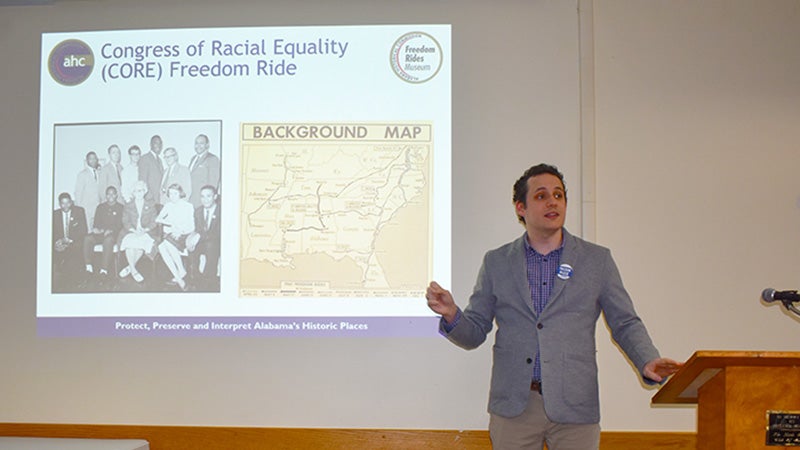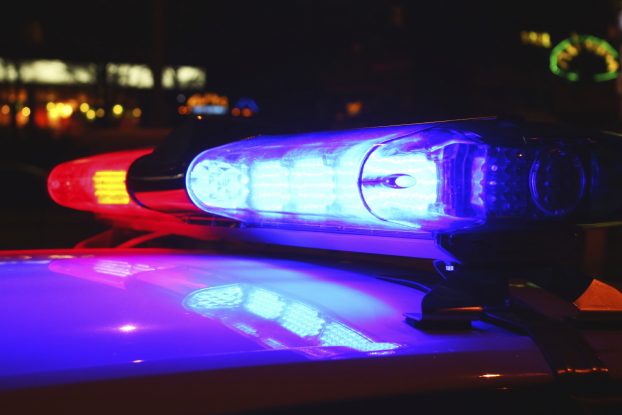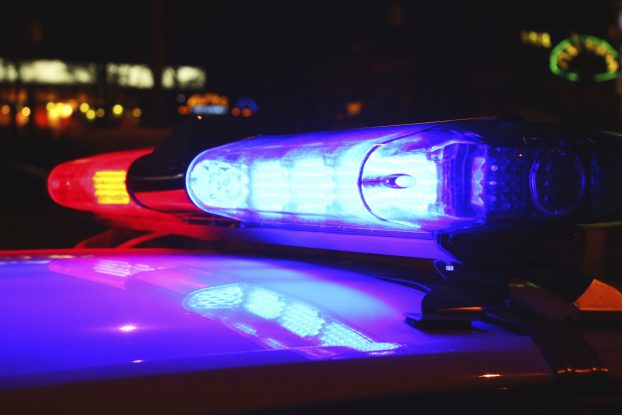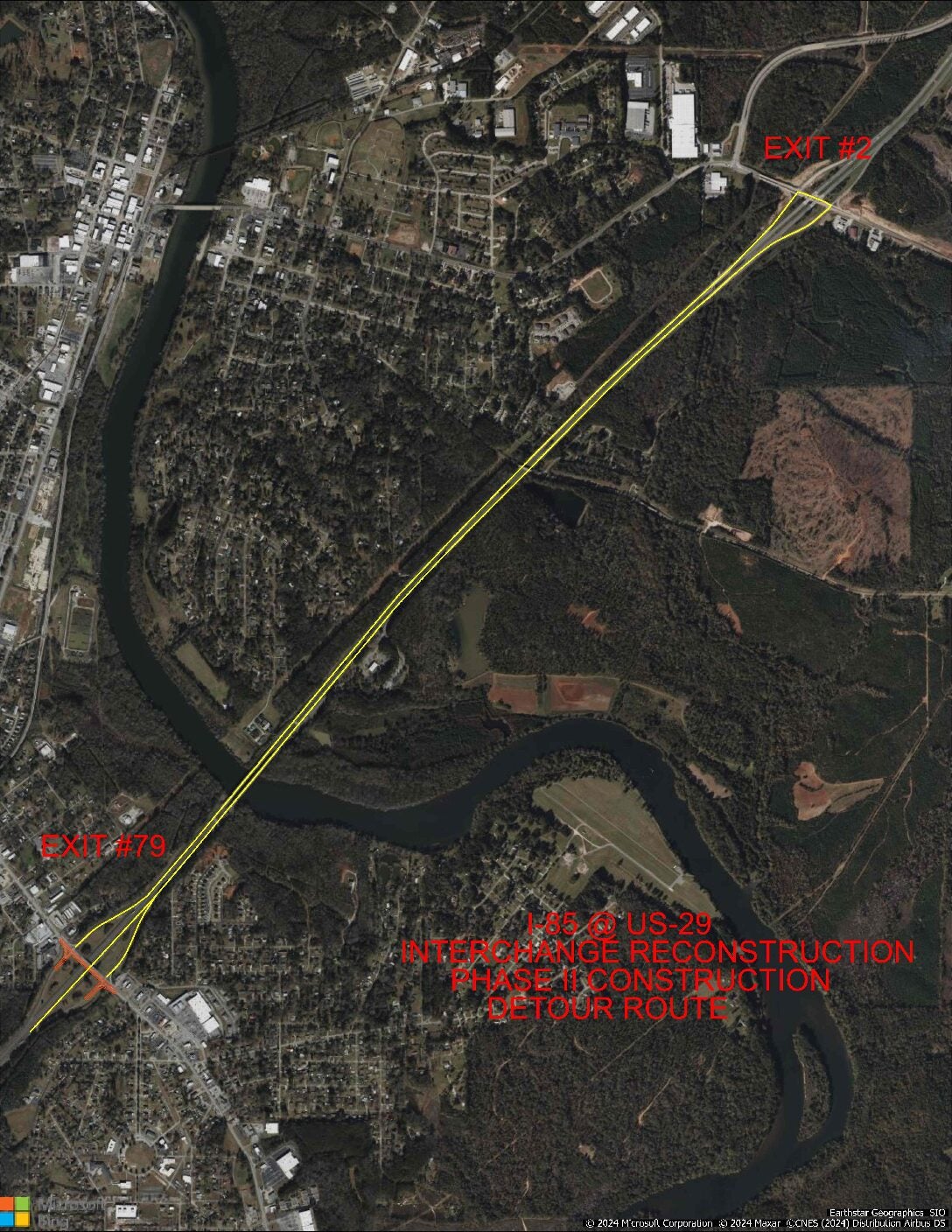Bradshaw library remembers Freedom Ride for Black History Month
Published 9:30 am Saturday, February 4, 2023
|
Getting your Trinity Audio player ready...
|
VALLEY — As a special program during Black History Month, Bradshaw-Chambers County Library on Thursday hosted a program about the Freedom Rides in Alabama in 1961. Alexander Strickland, assistant site director for the Freedom Rides Museum in Montgomery, talked about this campaign in the spring and summer of 1961. It played a big part in ending the practice of segregated travel by bus.
A native of Auburn, Strickland studied history at Auburn University and at the College of William and Mary. He has taught classes at Southern Union and AUM. The Freedom Rides Museum is located in an historic building that once housed a bus station. On May 21, 1961, a group of Freedom Riders were attacked and beaten there. which Freedom Riders were attacked by a mob on May 20, 1961. The museum is now operated by the Alabama Historical Commission and the State Historic Preservation Office.
In being willing participants in the Freedom Rides, a total of 436 people risked their lives and their freedom to make a statement about human equality. The participants included Black and White men and women and youth from 35 states.
Strickland explained that the 1961 Freedom Ride didn’t just happen overnight. Events had been leading to it since the late 1940s. In the spring of 1947, a Journey of Reconciliation took place to challenge the segregation laws in the Southern U.S. A two-week journey by bus started on April 9 in Washington, D.C. and went as far south as North Carolina before turning back. Many historians contend that this effort served as inspiration for the Freedom Rides of 1961. Supreme Court decisions in the 1950s such as Brown v. the Board of Education, Rosa Parks’ arrest and the Montgomery bus boycott, led to it being taken as the next step toward ending racial segregation.
James Peck, a white man who took part in the Journey of Reconciliation in 1947, took part in the 1961 Freedom Rides. He would be severely beaten in Birmingham.
The 1947 bus trip turned back after some riders were arrested.
Strickland said that a 1955 Supreme Court decision, Sarah Keys v. the Carolina Coach Company, had been a landmark case in the Civil Rights movement. Keys was a private in the Women’s Army Corps in 1953 and filed suit after she had been arrested for refusing to give up her seat on a bus. She had been allowed to sit there when her trip started, but when the bus crossed into a Southern state she was asked to give up that seat and go to the back of the bus. In its decision, the high court held that the non-discrimination language in the Interstate Commerce Act banned the segregation of Black passengers on buses that crossed state lines.
Boynton v. Virginia in 1960 was a another landmark case. The case overturned a judgement convicting an African-American law student from Selma, Alabama for trespassing. Bruce Boynton was a law student at Howard University in Washington, D.C. when he sat down at a Whites only lunch counter in a bus station in 1960. The police were called, and he was arrested for trespassing. Boynton’s mother, Amelia, was later beaten near the Edmund Pettus Bridge in Selma in 1965 and became an icon of the Civil Rights movement.
By 1960, the court had ruled that bus companies could not ban black passengers from interstate travel or from sitting at lunch counters.
Strickland explained that in 1961 James Farmer, head of the Congress of Racial Equality (CORE), wanted to have a Freedom Ride across the Deep South. It was basically a follow through of what the Journey of Reconciliation had attempted 14 years earlier.There were some minor incidents in Virginia, the Carolinas and in Georgia, but when the group met with Dr. Martin Luther King, Jr. in Atlanta, they were warned not to go into Alabama. From his own experience in living in that state in the 1950s, Dr. King feared they would encounter some serious violence. They did.
Strickland said that the Freedom Ride was met with mob violence just after crossing the Alabama state line on US 78. During a brief stop in Anniston, someone slashed tires on the bus. The bus managed to get out of town but had to stop just outside the Anniston city limits. A mob made up of Klansmen attacked the stalled bus, hitting it with rocks and bottles. Someone hurled in a Molotov cocktail, causing a fire inside the bus. As the riders attempted to exit the bus, members of the mob on the outside tried to hold back the exit door to keep them inside. An undercover state investigator brandished a pistol at them, telling them to let everyone out. Everyone escaped from the burning bus, only to be beaten by known Klansmen once outside. Many in the mob came to the broken-down bus in church attire rather than in the customary white robes. It was on a Sunday and was Mother’s Day. They came to the mob scene in what they had worn to church. Highway patrolmen arriving on the scene broke up the confrontation by firing their pistols into the air. This may have prevented a mass lynching.
In 2017, the road site of the mob attack and the downtown bus station were dedicated as parts of the Freedom Riders National Monument.
Things only got worse when another bus the Riders were on reached the station in Birmingham. They were attacked by KKK members while the police did nothing to protect them. James Peck, who had been on the 1947 Journey of Reconciliation, needed 50 stitches for wounds he’d gotten on his head. He was first taken to the Carraway Methodist Medical Center, where he was refused treatment, and later to the Jefferson Hillman Hospital, where he was treated.
The mob beat the riders with baseball bats, iron pipes and bicycle chains.
When word of what had happened in Alabama reached Attorney General Robert Kennedy, he urged restraint on the part of the Freedom Riders and sent an assistant, John Siegenthaler, to Alabama in an effort to calm the situation.
Despite what had happened in Anniston and in Birmingham, the Freedom Riders wanted to continue on to New Orleans. Kennedy ordered them an escort to Montgomery. There were radio reports of a huge mob at the bus station in Montgomery. Wanting to avoid trouble, the bus drivers refused to go on.
The riders then decided to finish their journey by plane, only to have their flight receive bomb threats.
They got to New Orleans without incident, and the ride was over. But the cause they started went on.
Strickland said that Diane Nash, a Tennessee college student who headed the Nashville Student Movement, believed that if Southern violence was allowed to halt the Freedom Rides the movement would be set back for years. She sought others to join her in continuing the rides. On May 17, a new set of riders including ten college students took a bus to Birmingham, where they were arrested and jailed by Public Safety Director Bull Connor. Behind bars, the students kept their spirits up by singing freedom songs. Out of frustration, Connor drove them north and put them out at the Tennessee state line. Not long after that, though, the riders were back in Birmingham.
Freedom Riders from all over the U.S. joined the movement. They included a 21-year-old college student named John Lewis. He was a native of Troy, Alabama, and Dr. King liked to call him the boy from Troy. In his home state, Lewis would get into what in later years he would call good trouble.
On May 19, Lewis and Hank Thomas went to Birmingham to lead a new Freedom Ride. A mob assembled at the bus station to jeer them, and no bus driver wanted that kind of trouble, good or not. At the bus station in the state capital, located on Court Street, a howling mob awaited. Escorted by the Alabama Highway Patrol, the bus reached speeds at 90 miles an hour to make it to Montgomery. The escort peeled off at the city limits, and the riders would not get any help from the local police. At the bus station, the riders were severely beaten by the mob. Reporters and photographers were attacked first. Their cameras, microphones and taping devices were destroyed. Siegenthaler, a Justice Department employee, was knocked unconscious and left lying in the street. Ambulances refused to take them to local hospitals.. They were rescued by local Black residents and treated in their homes.
On the following Sunday, an estimated 1.500 people jammed into the Baptist church in Montgomery that was pastored by the Rev. Ralph David Abernathy. Among the speakers that day was Dr. Martin Luther King, Jr., who had previously led the Montgomery bus boycott. Outside the church, a mob of up to 3,000 angry white residents had gathered, armed with baseball bats and metal pipes. City police and State Troopers had been ordered not to get involved.
Leaders of the service contacted President Kennedy for help. Kennedy, in turn, contacted Alabama Governor John Patterson and told him to disperse the crowd or he would bring in the National Guard. Patterson had already acted to do that with the Alabama National Guard by the time the president called.
The Freedom Ride continued into Mississippi, where the riders were arrested and sent to Parchment Prison, where they were kept in a solitary confinement area on death row, were stripped to their underwear and allowed no mail privileges. More Freedom Riders were arrested in Mississippi. They, too, were sent to Parchment. More than 300 were there at one time. They were not allowed to have mattresses, sheets or toothbrushes.
When President Kennedy called for a cooling off period, CORE President James Farmer responded, “We have been cooling off for 350 years. If we cool off any more, we will be in a deep freeze.”
The strife died down by the end of summer, but the Freedom Rides did have the effect of motivating more Blacks in the rural South to support the civil rights movement. Southern Black activists generally organized around churches, the center of the Black community and a base of moral support.This later led to voter registration drives. The courts made sure the process was fair. Up until the 1960s, Black people who wanted to vote had to take literacy tests that were supervised by White administrators. Such tests often included questions no one could answer. The poll tax also kept poor people, both Black and White, from voting.
On Monday, Feb. 23, the Bradshaw-Chambers County Library Travelers will be making a trip to the Freedom Rides Museum in Montgomery. They will also be making visits to the Civil Rights Memorial Center, the Rosa Parks Museum and the Alabama Voices Museum at the Alabama Department of History. The cost is $55, due at registration. This covers admission to these sites and motorcoach transportation. Those taking part will also have lunch at Chappy’s Deli, a well-know spot in the state capital.
For more information, call the library at (334) 768-2161 or email: programs@chamberscountylibrary.org.





